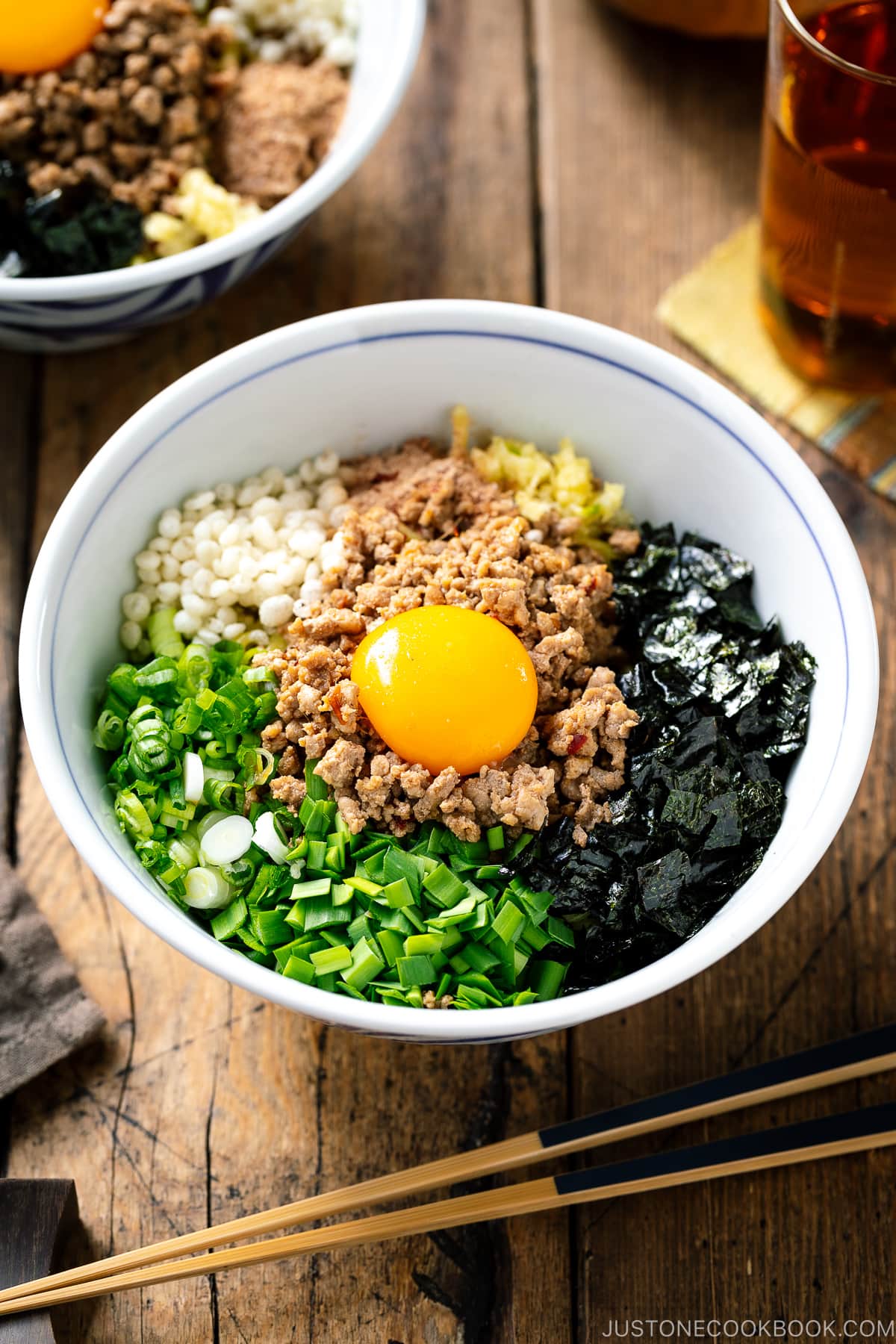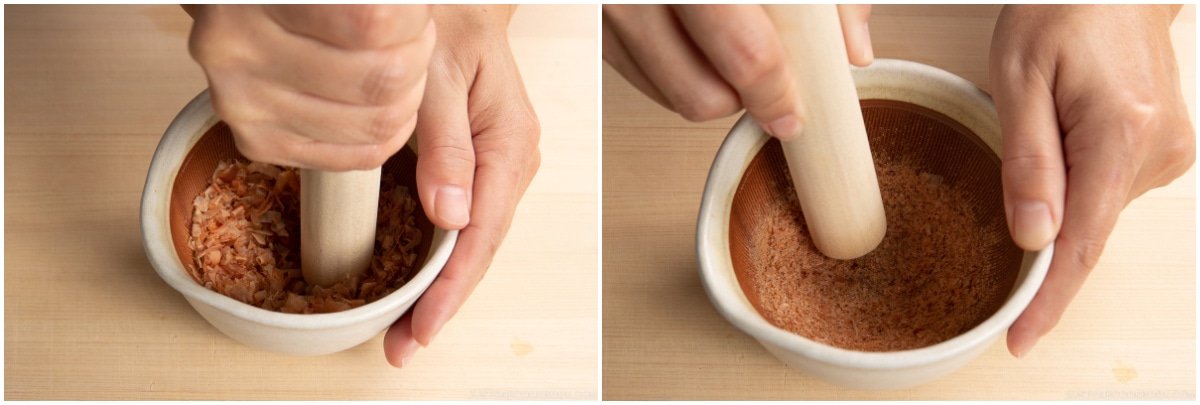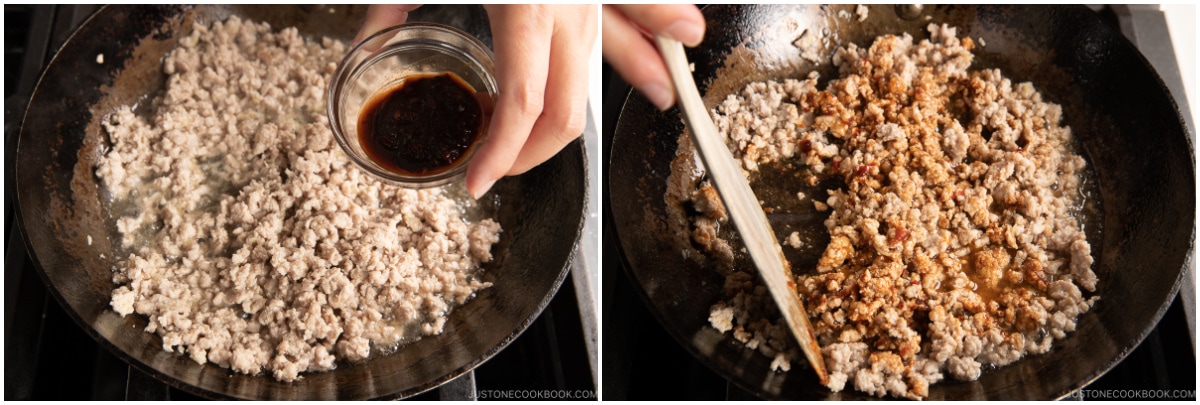Mazesoba, often called Mazemen here in the US, is Japanese brothless ramen that originated in Nagoya. The thick, chewy noodles are mixed with well-seasoned minced pork, garlic chives, green onion, nori seaweed, katsuobushi powder, and sous vide egg yolk. The creamy texture and savory flavorings make this a satisfying treat.

Mazesoba (まぜそば), a Japanese brothless ramen noodle, was one on our must-eat list when we visited Nagoya several years ago. Nagoya food or Nagoya meshi (名古屋めし) is unique to Nagoya and its surroundings in Aichi Prefecture and cannot be found anywhere else in Japan.
I’ve shared a few well-known Nagoya meshi such as Miso Katsu, Hitsumabushi (Unagi Chazuke), Nagoya-Style Fried Chicken Wings, and Ogura Toast on the blog. And today, I’m bringing you the popular mazesoba (or mazemen) recipe that can easily be made at home!
For those in the US, you might have tried mazesoba being served as one of the versions of mazemen (まぜ麺). As more authentic ramen joints started to offer mazemen on their menus, this soup-less style ramen is becoming a mainstream style of ramen. Just recently, I’ve also discovered that a broth-less ramen chain Kajiken is opening in my neighborhood and I’m looking forward to trying it out.
Table of Contents

What is Mazesoba?
Mazesoba (まぜそば), or what we often call the Taiwan-style mazesoba (台湾まぜそば) or sometimes mazemen, translates to ‘mixed noodles’ in Japanese. It is a soup-less variety of ramen originated in Nagoya city.
This ramen is composed of thick chewy noodles, ground pork mixture, and a variety of toppings such as green onions, garlic chives, minced garlic, and egg yolk. This dry-style noodle doesn’t come with any broth, so the flavors rely heavily on the savory pork mixture and toppings.
Mazesoba came about in 2008 from a specialty noodle shop called Menya Hanabi (麺屋はなび). The owner wanted to make Taiwan ramen, a Nagoya specialty dish but he couldn’t achieve a good soup broth that was to his satisfaction. When he was about to throw away the minced meat, one of his part-time workers suggested serving it with boiled noodles. The cook improved the dish and that gave birth to the current “Taiwan mazesoba.”
The Difference between Mazesoba, Mazemen, and Abura Soba?
Oftentimes, when a specific dish is being transported outside of Japan, it’s very likely being renamed, loosely translated, or reinvented for various reasons.
In the US, mazemen (まぜ麺) has come to be the customary term for Japanese broth-less style ramen. I take it as a rebranding and that allows more room for chefs to come up with their own renditions. You’ll find all sorts of creative interpretations from uni mazemen, soft shell crab mazemen to mentaiko mazemen being offered at restaurants. They all share similar components: thick-style noodles, tare (seasoning), sometimes seasoned oil, and toppings, but without the soup/broth.
On the other hand, you’ll also find abura soba (油そば), which is another popular broth-less ramen dish almost identical to mazesoba. They were originally the same dish, but both have evolved with slightly different characteristics. The main difference is how the noodles and sauce are combined.
In general, mazesoba is served with seasoned pork mixture and garnished with more toppings. Abura soba is usually served with a few slices of pork belly chashu with fewer toppings, and the sauce is placed underneath noodles so you have to mix them all up when you eat.

Ingredients for Mazesoba
- Ramen Noodles – I recommend getting thick ramen noodles. Sun Noodles in the US sells Mazemen noodle packages that include 2 packs of thick noodles.
- Ground pork
- Seasonings: sesame oil, doubanjiang (chili bean paste), soy sauce, oyster sauce, sugar, chicken stock, and salt
- Aromatics: garlic, ginger, green onions, Chinese chives
- Toppings: nori seaweed, katsuobushi (dried bonito flakes), tenkasu (tempura scraps), sous vide egg yolk
Use of raw egg (or sous-vide egg):
In Japan, it’s safe to consume raw eggs, but not in the U.S. You can get pasteurized eggs or sous vide eggs. Egg yolk in this recipe adds a nice creamy texture and adds richness in flavor. You can also use Onsen Tamago, Soft-Boiled Egg, or poached egg.
Substitute for Vegan/Vegetarian:
You can swap the ground pork easily with meat alternatives (tofu, meat crumbles, etc). Use vegetarian stir fry sauce instead of oyster sauce and vegetable stock instead of chicken stock.
Please skip katsuobushi and sous-vide egg yolk.
How to Make the Best Mazesoba
- Prepare all the ingredients.
- Stir fry and season the ground pork.
- Cook the ramen noodles.
- Assemble the noodles and all the toppings.

Mazesoba Cooking Tips
- Cut the toppings into the same size pieces. This is crucial for creating a specific presentation for the noodle dish and for easy mixing.
- Reserve the cooking liquid for the pork mixture. As you simmer the pork mixture, the cooking liquid will be reduced and flavors will be concentrated. However, you want to reserve some cooking liquid for the meat so the ground pork mixture has some fat and liquid to intertwine with the noodles.
- Serve the dish immediately while it’s warm. This is actually quite important! Since some of the toppings are at room temperature, the dish gets cool faster than the typical ramen with a broth. Once the noodles get cold and stick to each other, it’s very hard to mix it all up and the dish becomes less appetizing.

How to Enjoy Mazesoba
While it’s slightly warm, mix the noodles and toppings with chopsticks. It’s much easier to mix them up when both noodles and pork mixture are warm. Thick wavy noodles are specially used for this dish so that noodles cling well with the toppings.
Personally, I love adding more katsuobushi powder to my noodles than I specified in the recipe. Because the pork mixture itself is well seasoned, the katsuobushi powder would not be overpowering. Instead, it adds an umami depth to the dish.
When you finish eating the noodles, it’s possible that some seasoned minced pork is left in the bowl. In Japan, it’s very common to ask for an oi-meshi (追い飯), a bowl of steamed white rice. You can add the steamed rice to the leftover pork mixture and you mix them up to eat.
If you have extra seasoned pork, freeze the leftovers for later use. My kids love the rice ball made with this minced pork. I simply defrost the meat toppings and mix them with steamed rice. Then, make rice balls.
More Delicious Noodle Recipes
- Miso Ramen
- Tsukemen (Dipping Ramen Noodles)
- Curry Ramen (Midnight Diner: Tokyo Stories 2)
- Vegetarian Ramen

Wish to learn more about Japanese cooking? Sign up for our free newsletter to receive cooking tips & recipe updates! And stay in touch with me on Facebook, Pinterest, YouTube, and Instagram.

Mazesoba (Mazemen) – Japanese Brothless Ramen
Video
Ingredients
For the Seasoned Pork
- 1 Tbsp toasted sesame oil
- ½ lb ground pork (use meatless crumbles or tofu for vegan/vegetarian)
- 1 clove garlic
- ½ tsp ginger (grated; from a 1-inch, 2.5-cm knob)
- 1 Tbsp sake
- 1 Tbsp doubanjiang (spicy chili bean paste)
- 1 Tbsp soy sauce
- 2 tsp oyster sauce (use vegetarian stir-fry sauce for vegan/vegetarian)
- 1 tsp sugar
- 3 Tbsp chicken stock/broth (use vegetable broth for vegan/vegetarian)
- ¼ tsp Diamond Crystal kosher salt
For the Other Toppings
- 2 green onions/scallions
- 1 small bunch garlic chives (Chinese chives or nira) (1 oz, 30 g)
- 3 packets katsuobushi (dried bonito flakes) (each individual packet contains 2 g; skip for vegan/vegetarian)
- 1 sheet nori (dried laver seaweed)
- 2 cloves garlic
For the Noodles
- 2 servings fresh ramen noodles (I used Sun Noodle Mazemen fresh noodles)
- ¼ tsp Diamond Crystal kosher salt (for seasoning the noodles)
- 1 tsp toasted sesame oil (for seasoning the noodles)
For Serving
- 2 Tbsp tenkasu/agedama (tempura scraps)
- 2 large egg yolks (In Japan, raw eggs are safe to consume; you can buy pasteurized eggs or sous vide your own eggs for safety; you can also use Onsen Tamago, Soft-Boiled Egg, or poached egg; skip for vegan/vegetarian)
Instructions
- Gather all the ingredients. Bring a large pot of water to a boil. Once boiling, turn off the heat and cover until you‘re ready to cook the noodles. Prepare the toppings and seasoned pork while you‘re waiting for the water to boil.

To Prepare the Toppings
- Thinly slice 2 green onions/scallions. Cut 1 small bunch garlic chives (Chinese chives or nira) into pieces ⅛ inch (3 mm) wide. Set them aside.

- Put 3 packets katsuobushi (dried bonito flakes) in a Japanese mortar and grind it with a pestle until powdered.

- Cut 1 sheet nori (dried laver seaweed) into pieces ¼ inch (6 mm) square.

- Peel and grate the ginger (I use a ceramic grater) and measure ½ tsp ginger (grated, with juice).

- Mince or crush 1 clove garlic (I use a garlic press) for cooking the meat and set aside along with the grated ginger from the previous step. Additionally, mince or crush 2 cloves garlic and set aside for serving.

- Separate the 2 large egg yolks from the egg whites, if you haven‘t already. I use a slotted spoon to separate the yolks and whites of eggs that I cooked sous vide (I heated the eggs gently using an immersion circulator).

To Prepare the Seasoned Pork
- Heat a large frying pan on medium heat. When the pan is hot, distribute 1 Tbsp toasted sesame oil evenly and add ½ lb ground pork.

- Cook the ground pork until it‘s no longer pink. Add the grated ginger and minced/crushed garlic. Stir for 1–2 minutes until fragrant.

- Add 1 Tbsp sake and mix well.

- Add 1 Tbsp doubanjiang (spicy chili bean paste) and stir until combined.

- Add 1 Tbsp soy sauce and 2 tsp oyster sauce and mix well.

- Add 1 tsp sugar and 3 Tbsp chicken stock/broth and mix. Let it simmer on medium-low heat for 2–3 minutes. If the cooking liquid is evaporating fast, add some water (or more chicken stock). Leave some cooking liquid in the pan, and later, you will add this liquid to the serving bowls to season the noodles.

- Finally, taste the pork mixture and add ¼ tsp Diamond Crystal kosher salt, if needed. Turn off the heat and set it aside.

To Cook the Noodles
- Reheat the large pot of water to a boil. Separate and loosen the fresh noodles with your hands before adding to the boiling water. Cook 2 servings fresh ramen noodles according to the package instructions. I usually cook the fresh noodles al dente (about 15 seconds less than the suggested cooking time). Stir the noodles once in a while to make sure they do not stick to the bottom of the pot.

- Once the ramen is finished cooking, drain it in a sieve. Shake off any excess water.

- Divide and transfer the noodles into individual ramen bowls. Next, mix 1 tsp toasted sesame oil and ¼ tsp Diamond Crystal kosher salt in a small bowl for seasoning the noodles.

- Divide and drizzle the sesame oil mixture into the noodles. Use chopsticks to loosen the noodles and coat them well with the sesame oil mixture.

To Assemble and Serve
- First, put the seasoned pork with its cooking liquid on top and in the center of the noodles and create an indentation to hold an egg yolk. Next, divide and place the green onions, garlic chives, katsuobushi powder, nori seaweed, crushed garlic, and 2 Tbsp tenkasu/agedama (tempura scraps) in small piles around the pork. For each serving, place 1 large egg yolk in the indentation in the pork. Serve warm. Mix the noodles and toppings with chopsticks until the egg yolk is well incorporated and enjoy.

To Store
- You can keep the leftovers in an airtight container and store them in the refrigerator for up to 3 days. You can store the seasoned pork in the freezer for up to a month. I sometimes mix this seasoned pork with steamed rice to make rice balls for my kids' lunch.





























Loved this. I did cheat with some changes that rob it of authenticty. I soaked about 6 shitake and added them chopped to the meat. Also added 1/2 tbsp of sweet flour paste (although it is Chinese) Super tasty and will make this again!
Hi afra! Thank you so much for trying Nami’s recipe and sharing your cooking experience with us.
We are glad to hear you enjoyed it and will make it again. Happy Cooking!
Hi! I am so excited to try this recipe! Although, I am pretty young. What can I use instead of Sake and how can I lower to cholesterol and/or fat content in this dish? This dish looks delicious anyways!
Hello LK Ytch! Thank you so much for trying Nami’s recipe!
You may use Dashi for Sake, and you can leave off the egg yolk for less cholesterol and fat.
We hope this was helpful!
So easy and delicious, perfect effort to reward ratio. I make this once a week now for dinner and the next day’s lunch and always look forward to it! I like to add a chopped dried chilli with the garlic and ginger for extra spice.
Hi Carly, We are so happy to hear you enjoyed this dish.
Additional chili and garlic ginger sounds great as well. 🤩 Thank you so much for trying Nami’s recipe and sharing your tip and experience with us
This was excellent! I had mazesoba for the first time at a restaurant on a trip recently and wanted to recreate it at home. So pleased with how it turned out and will definitely be making this again.
Hi Christine! Aww.🥰 Thank you so much for your kind words about Nami’s recipe!
We are so happy to hear you enjoyed the homemade Mazesoba.
Thank you for trying Nami’s recipe!
I loved this recipe, thanks!! my husband is Japanese and he loved it as well! I added Okura as well , grounded tofu instead of pork and salmon to it 🙂 oishikatta! arigatou 🙂
Hi Nadine! Thank you for reading Nami’s post and experimenting with her recipe!
We are glad to hear you and your husband enjoyed it. Thank you for sharing your experience!
Love your website and recipes. Is the nutritional info for the entire recipe, or one serving? I have high blood pressure, and have to watch the sodium. 🙁
Hi Bill, Thank you for reading Nami’s post and trying her recipe!
The nutritional info is for approximately one serving. To reduce sodium content, you can skip all the salt in the recipe and try using half of the condiments. It works well. If you want to add more flavor, you can add a hint of vinegar.😉
We hope this helps!
We have a mazemen shop open in Costa Mesa last year called Mogu Mogu. It’s delicious and I go literally every week. Their thick, chewy, brothless noods are sooo good.
Thanks for sharing a home recipe! Can’t wait to try it!
Hi Londa! Thank you for reading Nami’s post and sharing the info!
We hope you enjoy Nami’s Mazemen as well. Happy Cooking!
Great recipe! Can’t wait to try it out. It’d be awesome if you could also do an Abura Soba recipe too. Thanks for always having great content!
Hi Carissa! Thank you very much for your kind feedback and request for the Abura Soba recipe!
We will make sure to add it to Nami’s list. 😉
I love the new logo Nami-san!! Especially the added addition of JOC in katakana!! The website looks great.
Side note: A few weeks ago, one of my Peloton workouts finally overlapped with yours as we do follow each other and we were able to “high-five”. I was so excited! hahaha
Hi MaiTai26! Thank you very much for your kind feedback!
Nami and all of us at JOC are so happy to hear you love our new logo and enjoying the workout community at Peloton!
Happy Cooking and workouts! 🤗
Great new logo and site refresh and yes I think you have been captured in the image of you lady.
The dish looks incredible, now I have to see if our nearby Asian store has whats needed. .
Hi Ron! Thank you very much for your kind feedback and compliment on our new logo!
Nami and all of us at JOC are so happy about your positive feedback. Happy Cooking! 🥰
Thank you for this recipe! I was looking for a recipe for “abura soba” for quite some time. Although I realize that it’s not quite the same, it seems to be rather similar and as far as I know I do like “maze soba”, so I’m really looking forward to try it out ^^
Hi Marina! Thank you very much for reading Nami’s post and trying her recipe!
We hope you enjoy Nami’s Mazesoba recipe. Happy Cooking! 🧑🍳
This looks delicious! What if I don’t have something with which to sous vide my egg? It seems like the flavour won’t be complete without that egg yolk.
Hi Erika! Thank you for trying Nami’s recipe!
Instead of sous-vide egg, You can also use Onsen Tamago, Soft-Boiled Egg, or poached egg.
You can also skip the egg and still have a good flavor from other ingredients.
We hope this helps and that you enjoy the dish. 🙂